The church Notre-Dame d' Agonges
 The
church of Agonges was built on a central mound, in the middle of a
series of worked hillocks make of hand of man or work observation posts
of defense. Depending until the revolution of the diocese of Bourges,
possession of the abbess of Saint-Menoux, this parish is mentioned for
the first time in 1138 pennies the term “Sanctae Mariae de Agongis”.
The
church of Agonges was built on a central mound, in the middle of a
series of worked hillocks make of hand of man or work observation posts
of defense. Depending until the revolution of the diocese of Bourges,
possession of the abbess of Saint-Menoux, this parish is mentioned for
the first time in 1138 pennies the term “Sanctae Mariae de Agongis”.
 Built
at the end of XIIth century and the beginning of XIIIth, the current
building belongs to the Roman style of transition. Indeed, if it is
Roman by its general plan ,the ornamentation of her gates and its
capitals, its narrow openings in semicircular arch, its apse and its
absidioles arched in half dome, it is Gothic by the vault of its nave.
Built
at the end of XIIth century and the beginning of XIIIth, the current
building belongs to the Roman style of transition. Indeed, if it is
Roman by its general plan ,the ornamentation of her gates and its
capitals, its narrow openings in semicircular arch, its apse and its
absidioles arched in half dome, it is Gothic by the vault of its nave.
Moreover,
built with the crossroads of three dioceses (Bourges, Autun and
Clermont), this construction underwent at the same time the influence
of the Burgundian schools, from Auvergne and Berry.
 The
external walls present a stone marriage of size and hardcores of varied
colors passing from the gray and white at the pink and the yellow. The
stones of gray or pink colour are out of sandstone of the country, the
others out of limestone with phrygranes of the valley Allier.
The
external walls present a stone marriage of size and hardcores of varied
colors passing from the gray and white at the pink and the yellow. The
stones of gray or pink colour are out of sandstone of the country, the
others out of limestone with phrygranes of the valley Allier.
 The
southern side door is bored in a very projecting pediment, covered of a
glazing whose entablature is supported by modillons with carved
heads or chips. The bay is framed by three archivolts in arc slightly
broken which receive from share and others three columns whose torus is flated and with very simple capitals decorated with scales, foliages
and heads.
The
southern side door is bored in a very projecting pediment, covered of a
glazing whose entablature is supported by modillons with carved
heads or chips. The bay is framed by three archivolts in arc slightly
broken which receive from share and others three columns whose torus is flated and with very simple capitals decorated with scales, foliages
and heads.
 The
western gate does not make not covered on the pinion. Its oven walls
are decorated of a post engaged between two barley grains, and
internally framed column at Roman base and capital with foliage.
The
western gate does not make not covered on the pinion. Its oven walls
are decorated of a post engaged between two barley grains, and
internally framed column at Roman base and capital with foliage.
The northern wall of the nave carries the trace of a door in gothic arch which was walled. With the top of this old door, one can see a stone corbel. They are probably the indices of an old vault.
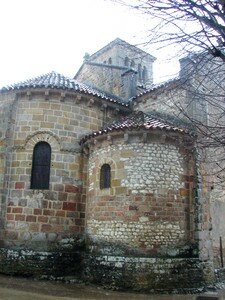 A cord of billets runs around the apse by circumventing the windows. The wall of this apse is reinforced by two flat buttresses.
A cord of billets runs around the apse by circumventing the windows. The wall of this apse is reinforced by two flat buttresses.
The pinions of the low-transept seem to have been elevated at one
unspecified time. Holes of rolls are still visible in the northern
pigon and on the northern wall. let us modilloons of the apse are with
simplified chips, those of the building are only grooved.
The
sacristy, old vault built subsequently, (probably in XVth century),
present of the ogival veins less rudimentary than those of the nave and
the more projecting buttresses.
 The
bell-tower, of Burgundian Roman style, rises of only one jet on the
side of the nave. Its higher part present, on each face, three stages
of blind arcades or windows. Blind blind arcades formed of three Roman
arches and four windows on the higher floor, separated by two simple
columns and two twin pillars. The face is presents only two stages of
bays and the northern face that only one.
The
bell-tower, of Burgundian Roman style, rises of only one jet on the
side of the nave. Its higher part present, on each face, three stages
of blind arcades or windows. Blind blind arcades formed of three Roman
arches and four windows on the higher floor, separated by two simple
columns and two twin pillars. The face is presents only two stages of
bays and the northern face that only one.
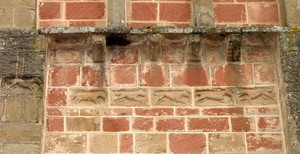 The
southern face of the bell-tower presents under the blind arcades, a
series of stones of apparatus decorated with low-reliefs of a very
popular invoice: characters blowing in a horn, current dog and animals.
The
southern face of the bell-tower presents under the blind arcades, a
series of stones of apparatus decorated with low-reliefs of a very
popular invoice: characters blowing in a horn, current dog and animals.
 The
style of these sculpture is to be brought closer that the characters
and animal observers on the arcs of the transept and certain capitals.
The presence of this unslung bestiary, Eastern origin, could be
dependent on the distance of the episcopal capacity, and more facility
to be able to transmit a message.
The
style of these sculpture is to be brought closer that the characters
and animal observers on the arcs of the transept and certain capitals.
The presence of this unslung bestiary, Eastern origin, could be
dependent on the distance of the episcopal capacity, and more facility
to be able to transmit a message.
The church is made of a single nave with four spans and of an arched transept of warheads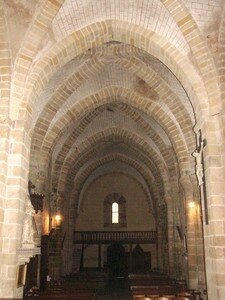 which
open on an apse in the same way plane, of a vault which prolongs the
southern arm of the transept (currently sacristy) and a square
bell-tower established on the southernmost side.
which
open on an apse in the same way plane, of a vault which prolongs the
southern arm of the transept (currently sacristy) and a square
bell-tower established on the southernmost side.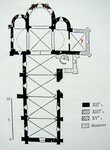
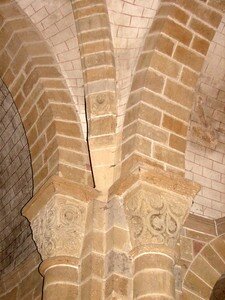 The
apse, arched in half dome, decorated internally with a blind arcade
on colonettes made up of three Roman arches under which the windows
open and which two small arcs in blind mitre separate. This type of
blind blind arcades “in mitre”, also known as “in pediment”, are found
in Bagneux, Montilly, Franchesse, Louroux and Chateloy.
The
apse, arched in half dome, decorated internally with a blind arcade
on colonettes made up of three Roman arches under which the windows
open and which two small arcs in blind mitre separate. This type of
blind blind arcades “in mitre”, also known as “in pediment”, are found
in Bagneux, Montilly, Franchesse, Louroux and Chateloy.
On the
internal face of each arc of the transept is archstones decorated with
16 figurines representing of the heads of monsters or faced animals, of
the squatted characters or on the back.
 The
capitals are more interesting: feuilages interlaced, heads of men and
deer, characters dancing. We thus have the initiate, laid down on the
ground, impregnated its terrestrial and animal part, which is rectified
to reach the sky.
The
capitals are more interesting: feuilages interlaced, heads of men and
deer, characters dancing. We thus have the initiate, laid down on the
ground, impregnated its terrestrial and animal part, which is rectified
to reach the sky.
It is in Agonges that the history of Notre-Dame of the Round began. Indeed, it is from here this black virgin comes. It is now in the vault of Chazeuil. (See Chazeuil and the legend of the black virgin low)

/https%3A%2F%2Fprofilepics.canalblog.com%2Fprofilepics%2F1%2F1%2F116167.jpg)
/https%3A%2F%2Fstorage.canalblog.com%2F49%2F16%2F312499%2F14620054_o.jpg)
/https%3A%2F%2Fstorage.canalblog.com%2F53%2F18%2F312499%2F14151229_o.jpg)
/https%3A%2F%2Fstorage.canalblog.com%2F07%2F05%2F312499%2F14149867_o.jpg)
/https%3A%2F%2Fstorage.canalblog.com%2F11%2F35%2F312499%2F14149307_o.jpg)
/https%3A%2F%2Fstorage.canalblog.com%2F90%2F14%2F312499%2F14125247_o.jpg)
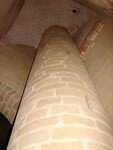


/https%3A%2F%2Fstorage.canalblog.com%2F12%2F98%2F137895%2F6624411_p.jpg)
/https%3A%2F%2Fstorage.canalblog.com%2F34%2F82%2F137895%2F27207854_p.jpg)
/https%3A%2F%2Fstorage.canalblog.com%2F32%2F37%2F137895%2F15872299_p.jpg)
/https%3A%2F%2Fstorage.canalblog.com%2F37%2F81%2F137895%2F15879822_p.jpg)